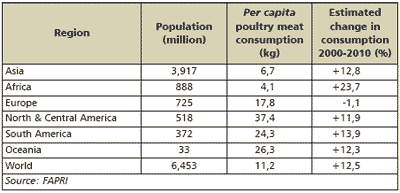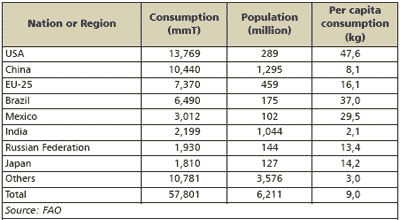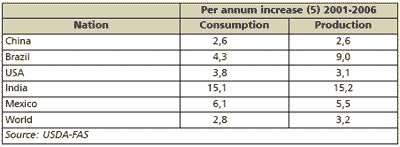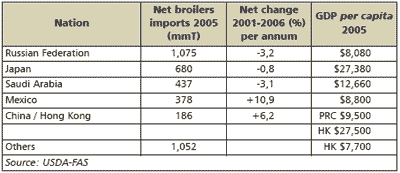The United States Department of Agriculture has estimated that total production of processed broiler meat in 2006 will reach 57.8 million metric tons. Given a population of 6.5 billion, world average consumption will attain 8.9 kg per capita during the present year. A considerable range in consumption exists depending on the availability and cost of broiler meat and the proportion of the population that is qualified to purchase either domestic or imported product.
Within nations, populations can be segmented by income level, ethnicity or location in rural or urban areas. These factors obviously affect per capita consumption and accordingly, average national values should be subject to analysis and interpretation when characterizing market opportunities for breeding stock, feed additives, equipment and pharmaceuticals.
Table 1 shows the wide range in average per capita poultry meat consumption for six regions of the world. The significant consideration is the forecast consumption during the first decade of this century. The Food and Agricultural Policy Research Institute of the USA projects an overall increase in consumption of 12.5%.
Only the EU-25 among the six regions will show a decrease in consumption, with solid growth in Latin America and Asia, which represent the areas of greatest growth opportunity. It is important to base proportional increases in consumption on the magnitude of the base level. A 1% increase in the USA or China represents a greater demand for ingredients and resources than an equivalent value for non-industrialized nations of Africa and Asia.
| Table 1:Poultry meat consumption by region (2006). |
 |
| Table 2:Consumption of broiler meat in major producing nations. |
 |
| Table 3: Balance between consumption and production of broiler meat 2001-2006. |
 |
| Table 4:Effective feed conversion efficiencies of broilers. |
 |
| Table 5:Major exporters of broiler meat in 2006. |
 |
| Table 6: Major importers of broiler meat in 2006. |
 |
Table 2 shows that the eight nations or regions representing 82% of world consumption have national average per capita values ranging from 2.1 kg for India to 47.6 kg for the USA. Most nations develop a balance between production and consumption since poultry meat is highly perishable unless it is stored at considerable expense in the frozen form.
Table 3 shows the relative increases in both consumption and production for the five-year period ending in 2006. With the exception of Brazil, there is a close relationship between production and consumption. Brazil has a highly developed export industry. This capitalizes on the use of inherent agricultural potential, labour resources, infrastructure and the discrepancy in value between the national currency of Brazil, the US dollar and the Euro.
It is generally accepted that the success of the broiler industry is attributed to the favourable feed conversion efficiency of modern hybrid broilers, coupled with the reproductive potential and short generation time of breeding stock. In calculating feed conversion efficiency of live broilers, the consumption of parent flocks is generally ignored but in the context of feed input to produce a broiler, a value of 0.5 kg per chick hatched should be included (Table 4).
Live feed conversion of a 2 kg broiler across a wide variety of production systems and climates including parent flock contribution can be accepted as 2.0 kg of feed per kg of live broiler. In the context of resource allocation, the effective feed conversion efficiency using cooked broiler meat is 3.8:1. The conversion of crude protein in the poultry diet to edible protein in broiler muscle is 2.5:1 but the conversion of sulphurcontaining amino acids is almost at unity. In the case of lysine, broilers are highly efficient converters and generate a 0.7:1 conversion based on the 1.2% lysine content of feed used in conventional broiler diets and the value of 6.5% lysine in broiler muscle.
Inherent environmental, economic and technologic factors are increasingly differentiating nations into major exporters or importers with the remainder in temperate and semi-tropical regions of the world demonstrating self-sufficiency.
Table 5 shows the net broiler exports of the EU-25 and the three leading nations. The US exports have remained static through the past five years. Thailand has been affected since 2004 by highly pathogenic avian influenza. In contrast, the export orientation of integrators in Brazil is confirmed by the 30% increase over a 5-year period. To maintain world balance, exports must be directed to a range of nations that lack selfsufficiency.
The five largest net importers are listed in Table 6.
During the past five years, the Russian Federation and Saudi Arabia have become progressively more selfsufficient and Japan has decreased imports from traditional suppliers, China and Thailand following the emergence of highly pathogenic avian influenza. Mexico and the People’s Republic of China have increased net imports, consistent with the increase in disposable income reflected in GDP per capita.
According to the FAO, 75% of the world’s poultry are maintained in intensive operations using confinement systems. Geographic concentration is dictated by proximity to markets, available infrastructure and low cost for feed, labour and other inputs. This has resulted in a decoupling between the location of broiler production and agricultural land that provides necessary feed ingredients.
Effectively, the availability of water for flocks and for processing is a major restraint to locating broiler operations. Transport of feed ingredients to the centres of production and outward freight of refrigerated product has been reduced to repetitive logistic and financial considerations. Decoupling imposes a significant demand on arable land to produce corn and soybeans, which represent the bulk of broiler diets.
Satisfying the demand for processed broiler meat while competing for vegetable-source proteins that constitute the diets of populations in developing nations presumes both larger areas for cultivation and increased yields. In 1990, a balanced diet in China incorporating 20 kg of animal protein per capita per annum could be produced from a land area of 1 Ha.
A Western diet with a combination of up to 80 kg poultry, beef and pork would require 4 Ha/capita/annum. Increased demand for broiler meat will place greater demands on the agronomic sector and will result in deforestation and conversion of grasslands to crop production. This in turn will require a greater supply of water for irrigation and will result in the release of nitrogen and phosphorus in agricultural run-off and plant effluent.
It is incumbent on the world’s major broiler producers to recognize the impact of expansion and to apply technology to improve efficiency of production in order to ameliorate environmental impact.
FORCES INFLUENCING DEVELOPMENT OF THE BROILER INDUSTRY PRODUCTION ECONOMICS
Profit from the production and marketing of broilers is derived from the margin between cost and realization. Traditionally, the broiler industry has involved extreme competition requiring innovation in product development, high levels of service both in domestic and international markets and commitment to quality and safety.
In the industrialized nations with mature broiler industries, expansion rates are harmonized with projections of demand. Realistic levels of expansion contribute to an orderly market, which is attractive to investors and contributes to stability. Most mature industries are characterized by consolidation in which a few large producers are responsible for the majority of output. Smaller integrators concentrate on products for specialized niche markets.
Maintaining sales volume in many countries is strongly dependent on continued purchasing power and ensuring profitability within the distribution chain. Prosperity mitigates in favor of both strong supermarket chains and quick-service restaurants, which are the significant intermediaries between broiler producers and consumers.
In many developing countries deficiencies in the distribution chain inhibit efficiency and profitability. These include the absence of a cold chain, a traditional preference for live chickens, and fragmentations among feed production, chick supplies, live bird production and processing.
Complete integration is necessary to achieve low-cost production, continuity of supply and quality.
Inevitably, successful broiler industries tend to follow the US pattern developed from the mid- 1940s onwards in which integration and expansion in a competitive environment results in consolidation.
Cost of production is the major determinant of profit and is a function of efficiency and scale of production. Fixed costs can be offset against volume through optimal utilization of facilities and corporate resources required for management, marketing and support services.
Feed represents the significant variable input, contributing as much as 70% to the production of live birds or 50% of processed broiler meat. The price of major ingredients, corn and soybean meal, are determined by supply and demand factors. These in turn are influenced by climate, patterns of land use, distribution infrastructure and government policy. The emergence of Argentina and Brazil as major exporters of ingredients, in competition with the USA, and increasing self-sufficiency in the EU-25 has been to the benefit of poultry producers worldwide.
The development of regulated commodity markets, the existence of large multinational ingredient traders and the availability of working capital allows large integrators to implement forward purchase of ingredients and to hedge prices to minimize risks and costs of acquisition of grains and other ingredients.
Advances in scientific nutrition of broiler breeders and growing stock, improved analytical techniques, efficient software and training programmes for nutritionists represent advantages to larger integrators but especially to exporters, where cost has a disproportionate effect on return on investment.
The demand for broilers fed allvegetable diets is an emerging trend.
Concern over BSE and the health risks associated with foodborne salmonellosis in addition to ethnic requirements have influenced dietary formulation and production costs.
Escalation in the price of fuel required for brooding, generation of heat and steam and for distribution of product has increased cost and eroded margins. An indirect effect of higher fuel cost relates to decreased purchasing power with consumers shifting purchase priorities to necessities. This in turn reduces demand for value-added products in favour of less expensive protein sources and degrades margins.
HUMAN AND POULTRY HEALTH FACTORS
The perception that growthpromoting antibiotics are deleterious to human health is reflected in the restrictions placed on use of these feed additives. The initiative assumed by Scandinavian nations and followed by the EU-12 is an irreversible trend.
Withdrawal of specific compounds with activity against Gram-positive intestinal flora renders flocks susceptible to clostridial enterotoxemia.
Appropriate changes in production techniques and the adoption of prebiotics, probiotics and fermentation products together with effective control of coccidiosis have allowed producers to maintain livability and growth rate in the absence of growth-stimulating antibiotics. In some markets, the premium that can be obtained for ‘drug-free’ broilers offsets the 5% deterioration in feed conversion efficiency.
From the time that intensification of the broiler industry commenced during the late 1940s, both erosive and catastrophic diseases have required investment in effective preventive measures and therapeutic agents. Advances in molecular biology which have translated into more effective vaccines, application of epidemiologic principles to reduce the risk of infection, and other procedures based on application of the principles of biosecurity have reduced the impact of disease.
The emergence of highly pathogenic avian influenza in southeast Asia and sporadic episodes in Europe has refocused attention on the risks associated with intensification and locating large integrations in limited geographic areas to take advantage of favourable environmental and marketing factors. It is possible that in the foreseeable future, risk of catastrophic disease may influence the location and structure of broiler integrations.
Foodborne infections including salmonellosis, campylobacteriosis and listeriosis have resulted in legislation and regulations that place maximum limits on carcass contamination. In addition to domestic rules, foodborne infections can be imposed as a barrier to trade. Commencing in 1999 the USDA-Food Safety and Inspection Service imposed a 20% upper limit on the proportion of carcasses from which Salmonella can be recovered.
Current average levels of contamination are in the region of 15% with approximately 12% of plants out of compliance.
Notwithstanding this situation, the US is obliged to offer a zero tolerance on Salmonella for exports to Russia and China, which is observed more in the breach than in reality.
ANIMAL WELFARE
Welfare has emerged as a major issue in design of facilities and management, both in the parent stock and broiler flocks. In developed countries, industry groups and their clients have agreed upon acceptable standards of welfare, which are committed to best management practices and are subject to audit.
Demands by animal activist groups to reduce stocking density, to require mechanical harvesting and controlled atmosphere impose additional costs that may be reflected in a premium for certified product delivery. In many cases, additional capital and operating costs required for upgraded welfare have to be absorbed by integrators.
FUTURE DEVELOPMENT OF THE WORLD’S BROILER INDUSTRY WORLD DISTRIBUTION
Concentration of poultry enterprises in limited geographical areas will be influenced by disease risk, environmental restraints, logistic factors and proximity to feed ingredients and markets. In some nations, enviromental legislation may restrain growth.
In developing countries economic advantages arising from a disparity between supply and demand will stimulate expansion to levels consistent with optimal financial return.
Industries that are committed to export will require dedicated complexes for their broiler products following the models in Brazil and Thailand. These units should be capable of producing a range of products in accordance with the specifications of client countries.
Considerations include antibiotic and other drug inclusions, feeding rendered animal fat and protein ingredients, and complying with desired live weight, packaging, labelling and documentation. It is possible that in the future product may be subjected to primary processing in one country and that further processing which may involve a high input of manual labour may be completed in dedicated plants in client countries.
It is evident that subsistence production of chickens using extensive management is vulnerable to infection with avian influenza, velogenic Newcastle disease and salmonellosis.
These ‘backyard’ and semi-commercial systems, which invariably involve live bird transport and sale, are incompatible with modern intensive production. This is evidenced by the epidemiology of H5N1 strain avian influenza in Asia which has persisted in non-commercial reservoirs in some nations since the mid 1990s.
The need to reduce the feed component of cost by enhancing efficiency will dictate the use of enzymes.
Balanced combinations of proteases, cellulases and other enzymes appropriate to dietary composition, can improve digestive efficiency by up to 10%. It is estimated that if the diets for 10% of the world’s commercially produced broilers currently were supplemented, 15 000 metric tons of commercial product would be required assuming an addition rate of 1 kg per ton.
Enhancing feed conversion efficiency by 5% in the USA alone would save two million metric tons of feed per year, generating a net increase in margin of $250 million to integrators or a benefit-tocost ratio of 4:1, assuming an addition cost of $1 per metric ton of feed. Incremental benefits could be obtained by increasing the nutritional value of the by-products of ethanol production, which will involve degradation of cellulose which does not take place in the digestive tracts of monogastric livestock.
Biotechnology will be required to develop and manufacture new vaccines to replace live attenuated biologics. Some progress has been made in producing geneticallyengineered vector vaccines based on HVT (herpesvirus of turkeys) and poxvirus. The current situation with avian influenza predicates development of an HVT-vectored, broad spectrum avian influenza vaccine that can be administered in ovo. The current pox-vectored vaccine is limited in its application due to the presence of maternal antibody.
The withdrawal of specific therapeutic agents including the fluoroquinolones and an increased incidence of drug resistance against other classes of antibiotics will place greater emphasis on improved housing, management and immunization to reduce the impact of E. coli septicemia.
Studies have shown the beneficial effect of enhancing the activity of the immune system. In many areas of the world, the use of Bio-Mos®, a mannan oligosaccharide feed additive, has been shown to improve both circulating antibody response and tissue immunity, especially in the intestinal tract.
New technologies will be directed to suppression of foodborne pathogens including Salmonella. Currently pre-harvest suppression of intestinal infection is largely ignored in the US but is undergoing evaluation and commercialization in countries with an export orientation.
Combinations of prebiotics and probiotics that modify intestinal flora will be applied to reduce the level of contamination entering processing plants. Practical experience in the US has shown that modalities such as hyperchlorination of spin chillers and bird washers coupled with increased water overflow in immersion tanks can reduce Salmonella contamination to levels approaching 10%.
The use of chlorine is inconsistent with the requirements of the EU, although alternative antibacterial additives are available at higher cost. Increasing overflow from approximately 20l to 35l per bird processed in the USA since 1999 has required extensive capital investment to process the increased volume of plant effluent.
Currently US broiler producers are in the unfortunate position of having to comply with the competing requirements of the USDA-FSIS with regard to bacterial contamination and with EPA and related state agencies concerning treatment and release of water.
Compulsory removal of antibiotic growth additives from diets, which has been mandated in the EU, will be extended to other countries, resulting in a small but quantifiable decline in feed conversion efficiency. Deletion of bacitracin, virginiamycin or lincomycin from diets may result in clostridial enterotoxemia.
This complex appears as necrotic enteritis, gangrenous dermatitis or botulism or a combination of these clostridialrelated conditions. Broiler integrators in the EU and those producing specialized ‘drug-free’ product in the US have adapted management and nutritional programmes to reduce the incidence of clostridial enterotoxemia.
Modalities include enhanced suppression of coccidiosis, acidification of drinking water, feeding probiotics and incorporating the Bio- Mos® mannan oligosaccharide in diets to suppress clostridial proliferation.
Mycotoxins responsible for both overt and subclinical toxicity are a major cause of decreased reproductive efficiency and depressed growth rate and quality in the broiler industries of the world. Climatic extremes including drought and unseasonable precipitation coupled with suboptimal post-harvest transport and storage exacerbate the severity of toxicity. Analysis of ingredients and rejection or segregation and blending of contaminated consignments is impractical in many situations.
Effective mycotoxin adsorbents based on cell wall extracts of Saccharomyces spp. can be incorporated into diets to ameliorate the effect of aflatoxins, fusariotoxins and other deleterious compounds. With increased specialization and the production of branded products with a high added-value component, processors must optimize yield and quality to maximize return.
Replacement of sodium selenite in diets with Sel-Plex® organic selenium reduces drip loss and improves colour of high-value fillets. Selenoamino acids, which are readily absorbed and metabolized, are more efficient than sodium selenite in protecting subcellular structures from peroxidation by free radicals derived from feeding non-stabilized lipids in ingredients.
Although conditions such as encephalomalacia, transudative diathesis and myodystrophy are seldom recognized as overt pathology under commercial conditions, subclinical changes involving increased permeability of the microvasculature will depress yield and detract from optimal quality.
CONCLUSIONS
In order to achieve projected rates of expansion based on estimates of future demand, broiler producers worldwide will have to adopt the benefits of biotechnology to enhance efficiency. This will be a prerequisite to maintain margins, which will provide a return on investment commensurate with risk. Survival and expansion in a competitive environment will be determined by ability to respond appropriately to operational restraints including the costs of fuel and ingredients, disease and government regulations. Long-term expansion can only be achieved by identifying and satisfying consumer demand and harmonizing production and marketing strategies.
Author: Simon M. Shane
Durham, North Carolina, USA
Presentation given at Alltech's 22nd International Feed Industry Symposium, held in Lexington, Kentucky, USA - April 23-26, 2006.
 | The previous article is a special collaboration from AFMA South Africa
(Animal Feed Manufacturers Association) and their magazine AFMA Matrix.
We thank AFMA for their continuous, kind support! |















.jpg&w=3840&q=75)